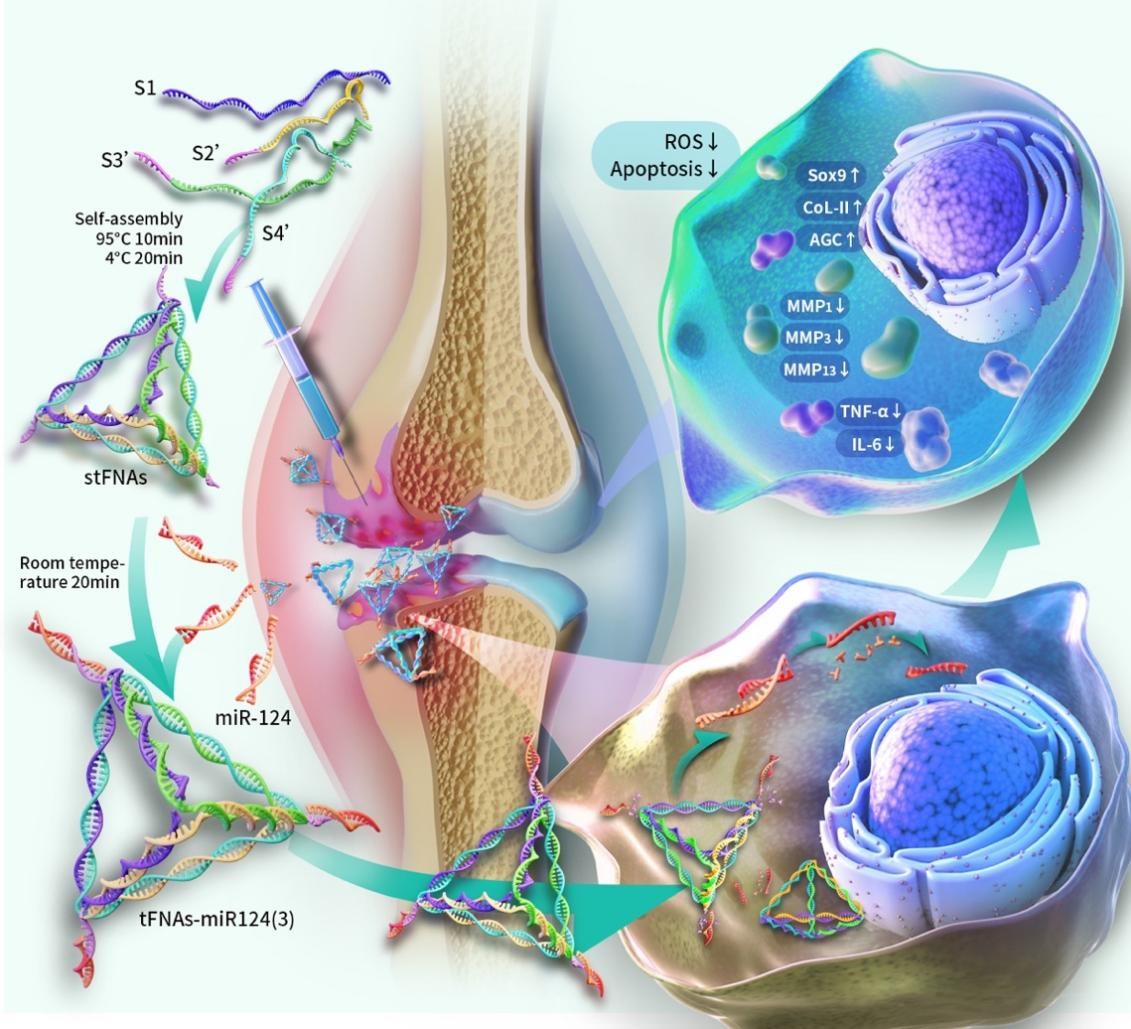Tetrahedral Framework Nucleic Acid Technology in Osteoarthritis Treatment
2024-06-28
Osteoarthritis (OA) is a typical degenerative joint disease that is highly prevalent among the elderly and increasingly affecting middle-aged and younger individuals.
There are many factors contributing to OA, with age being one of the most critical, which is why it is often referred to as "senile arthritis." OA is characterized by progressive destruction and loss of joint cartilage, synovitis, and subchondral bone remodeling.
According to the latest statistics from the National Health Commission in 2022, the number of OA patients in China has approached 140 million, meaning one in ten people has OA. Over one-third of these patients are aged 20-50, and this proportion is accelerating, even approaching the incidence rate seen in the elderly.
According to the diagnostic and treatment guidelines of the National Health Commission, the standard OA treatment course generally requires a follow-up after 3-6 months. The cost of using only nonsteroidal anti-inflammatory drugs (NSAIDs) per course is approximately 800 yuan, making the market size for each treatment course of OA reach 112 billion yuan.
Currently, the main treatments for OA include anti-inflammatory and pain-relieving medications and cartilage protection. Anti-inflammatory and pain-relieving drugs can only alleviate symptoms but cannot fundamentally repair cartilage damage. Cartilage cell regeneration treatments are primarily based on stem cell therapy, which is mostly in the early clinical research stages, with no successful cases and extremely high costs. Joint replacement surgery is one of the more effective OA treatments but is associated with high costs, extensive contraindications, and a painful procedure. Therefore, finding effective drugs and treatment methods for OA is a critical scientific challenge that needs to be addressed.
Innovative Mechanism of Tetrahedral Framework Nucleic Acids Loaded with T-miR3 for Osteoarthritis Treatment
1. Targeting Cartilage Cell Regeneration: T-miR3 promotes the expression of type II collagen (COL-II), proteoglycan (Aggrecan), and the stem cell transcription factor SOX9, which regulates cartilage regeneration. It also inhibits the expression of several matrix metalloproteinases (MMP-1, MMP-3, MMP-13). T-miR3 not only targets and extensively enters inflammatory cartilage cells but also demonstrates a strong retention effect at the site of injury.
2. Anti-Inflammatory: T-miR3 has a unique global anti-inflammatory and antioxidant capability. It effectively inhibits apoptosis of cartilage cells caused by osteoarthritis and promotes cartilage regeneration by suppressing the expression of inflammatory factors (IL-1B, IL-6, TNF-α, etc.).
3. Mechanism of Action: A significant portion of T-miR3 is absorbed by inflammatory cartilage cells. It works by inhibiting cartilage cell apoptosis, smoothing the cartilage surface, suppressing extracellular matrix (ECM) degradation, and increasing synovial thickness.

T-miR3 mechanism diagram
Core Advantages of the Approach
1. Cutting-Edge Technology with High Barriers: The successful synthesis of tetrahedral framework nucleic acid (tFNA) complex loaded with three microRNA-124 (T-miR3) has been achieved. Transmission electron microscopy (TEM) shows that the particle size is approximately 13 nm, with a uniform zeta potential of about -4mV, representing a globally unique technology.
2. Targeting Cartilage Cell Regeneration: T-miR3 promotes the expression of type II collagen (COL-II), proteoglycan (Aggrecan), and the stem cell transcription factor SOX9, which regulates cartilage regeneration. It also inhibits the expression of various matrix metalloproteinases (MMP-1, MMP-3, MMP-13). T-miR3 targets and extensively enters inflammatory cartilage cells, showing a strong retention effect at the site of injury in rat models. It also demonstrates good biocompatibility and drug metabolism, covering the mechanisms of current stem cell products.
3. Targeted Anti-Inflammatory Action: T-miR3 possesses a globally unique anti-inflammatory and antioxidant capability. It effectively inhibits apoptosis of cartilage cells caused by osteoarthritis and promotes cartilage regeneration by suppressing the expression of inflammatory factors (IL-1B, IL-6, TNF-α). It addresses the mechanisms of antibody-based therapeutic products.
4. Clear Patient Demand Orientation: T-miR3 can be highly absorbed by inflammatory cartilage cells. It significantly mitigates OA progression by inhibiting cartilage cell apoptosis, smoothing the cartilage surface, suppressing extracellular matrix (ECM) degradation, and increasing synovial thickness. This approach effectively and efficiently protects joint cartilage, addressing the fundamental needs of patients rather than merely alleviating pain symptoms.


